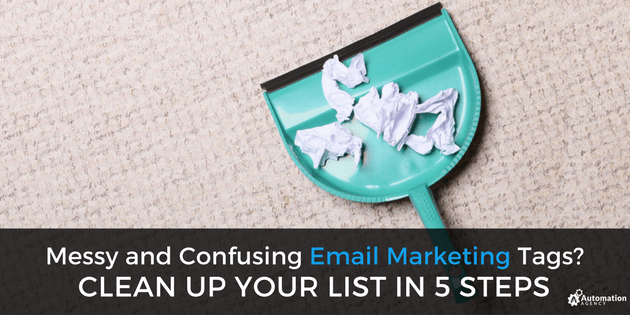Your email list makes it easy to keep in touch with your clients and customers. When you properly segment and segregate your list of subscribers, you can provide each individual with unique information, tailored to fit their needs, preferences, or habits. By including tags in your strategy, you can get even more specific with the blasts you send each of your subscribers.
Unfortunately, many marketers begin tagging their email list members too soon. Without a clear plan or strategy in plan, tags can become messy and confusing. The more tags you pile on, the more difficult it can become to understand what kinds of content the subscriber is looking for.
If your tags have gotten out of control, it’s important that you clean up your list as soon as possible. Not only will this help you establish stronger relationships with your target audience, but you’ll also make your email marketing much more efficient.
Want to find out if Automation Agency is the right fit for you? Take this quick quiz to find out!
5 Steps to Cleaning Up Your Email Tag List
Cleaning up your list of tags doesn’t need to be difficult. Here are five easy steps you can follow to clean up your tag list and start tracking your subscribers more efficiently.
1. Develop a Tagging Strategy
Before you begin tagging your list, you need to identify what you’d like to use tags for. Because tags are so easily added to your subscriber’s contact information, you can effectively use them for a number of reasons. However, if you try to apply tags to too many ideas, you’ll end up with a mess.
Think about what actions or behaviors might warrant a tag, as well as why tracking that information may be useful to you and your team. Establishing a strategy prior to tagging your subscribers can ensure you don’t get out of control when applying new tags. Your strategy should clearly define when a tag should be applied and what the purpose is of applying that tag.
2. Identify Your Tag Types
Once you’ve come up with a plan for tagging your subscribers, you need to identify the types of tags you’d like to use. Typically, there are three main tag types you may choose to use.
- “Context tags” are used for storing information that provide context about the individual. (e.g. topics they’re interested in.)
- “Action tags” are applied after a specific behavior is shown. (e.g. they filled in a form, registered for a webinar, or downloaded a lead magnet.)
- “Temporary tags” are used for triggering automations and get deleted after a specific amount of time. For example, when someone fills in a form using a 3rd party integration, you may apply a tag that triggers an automation. Once the automation starts, the tag is no longer needed.
When identifying your tag types, you want to consider your unique needs and strategies. If you find that a certain type of tag does not apply to your email list or the information you’re trying to track, don’t try to force that tag type into your strategy. Create a list of tag types that fit your needs.
3. Visualize Your Tags in a Spreadsheet
After your plan has been clearly established and your tags have been identified, you want to record this information to refer back to. In order to ensure your tagging system stays clearly defined and simple, you can create a spreadsheet that provides you with an overview of each of your tags.
Within your spreadsheet, you want to include the category of the tag, the purpose for that tag, and the different tag variations you may use. You should also include a brief description of the triggers that warrant each tag. Visualizing your tags this way can help your tags stay organized.
4. Create a Tagging Structure
When your tags don’t follow the same structure, it can be easy to forget what they mean or why they were applied. By developing a defined structure that each tag follows, you can identify what that tag means without having to refer back to your spreadsheet.
A simple tag structure that you may choose to follow may be Category – Subcategory – Details.
e.g. Webinar – Registered – Successful Selling 21st January 2018
When you use a structure like this, you can see exactly what behavior or trigger that individual performed to warrant the specific tag. However, you want to use a structure that fits your unique needs and the triggers you’ve identified.
5. Edit, Refine, and Merge Existing Tags
As your email list grows and changes, it’s natural to want to change up your tagging strategy. However, in order to prevent your tags from becoming a mess, you want to edit, refine, and merge tags consistently. When you solve problems before they can grow too large, you can keep your tag list clean and concise.
Look for opportunities to edit, remove, or even merge tags whenever you can. If a tag is no longer relevant, don’t be afraid to delete it. Likewise, ensuring each tag is categorized appropriately can help you keep your tag list efficient.
Tackling your tag lists can feel overwhelming. Yet the longer you let it go, the more difficult it will become to get your tags in order. If you’re struggling to come up with a tagging system that works for you,
And once you’re ready to implement the changes, Automation Agency can help. If your email marketing system is one of our supported platforms, just submit a task with the tags you’d like us to edit, remove, or merge, and we’ll take care of the rest.
Not an Automation Agency client? Take this quick quiz to find out if Automation Agency is the right fit for you.


